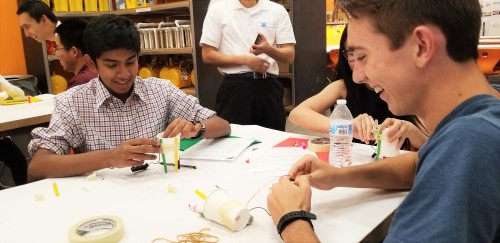How Can I Help Kids with Social Anxiety?
February 12, 2021
Why is Social Anxiety an Issue?
Many people have started to ask, Why is social anxiety becoming a bigger issue in society? If you looked back 40 years ago, no one would have known what social anxiety was, and very few would have experienced the issue as we know it today. I believe most students have social anxiety to some extent, and psychologists can probably identify many causes for this, but to me the issue is amazingly simple.
People get anxiety from things that they do not understand or doing things they aren’t good at. Because of the changes in society and technology, social interactions have become more complicated and students have less experience socializing. Hence, they have anxiety about it. These days, it is very difficult for students to understand the importance of social interaction. There are many reasons for this, but here are just a few:
- Technology–It has never been easier for people to record what you do, how you look, and what you say.
- Variability in people’s preferences–In the past, it was more acceptable to stereotype people (men/women, young/old, etc.) These days, when you meet someone, you can’t assume anything. For example, if you are a boy and you meet a girl, you can’t assume she is heterosexual. She could be homosexual, bisexual, transgender, or might not even associate with the terms “male” or “female” (non-binary).
- Flattened World–No matter where you go, you will meet someone from a different country, culture, or religion. This complicates social interactions because people will have different customs, ways of saying things, and preferences.
These days, students have fewer social interactions, and it’s even worse with the COVID-19 pandemic. As more social media apps are created, young people spend even less and less time socializing in person. The younger generations get most of their social interaction electronically, which means less and less time to even talk with their own families and people around them.
With all things considered, it is no surprise that people have social anxiety. But the factors I have mentioned only scratch the surface. There are many more things at play (health, wellness, diet, etc.)
In this article, I’ll share some tips that I use to help my students overcome their social anxiety.
The Secret: Make them Comfortable
 When we understand why social anxiety is an issue, it’s much easier to help someone who has it! If we assume that the social anxiety comes from confusion and a lack of practice, then it’s important to put students in a social situation that they can understand and that they can have success at it. We need to make them comfortable. We need to get them in social situations where they don’t have to worry about socializing.
When we understand why social anxiety is an issue, it’s much easier to help someone who has it! If we assume that the social anxiety comes from confusion and a lack of practice, then it’s important to put students in a social situation that they can understand and that they can have success at it. We need to make them comfortable. We need to get them in social situations where they don’t have to worry about socializing.
No matter how we do this, it will never be easy to help a student with social anxiety—especially if it is severe. But if you are going to help them, you need to create a safe environment for them. This environment will:
- Allow them to be themselves.
- Help them feel comfortable being themselves.
- Remove the pressure to do anything they don’t want to.
- Group like-minded individuals.
- Reduce the need to over-think interactions.
The main thing to make a student feel comfortable is minimizing their decision making. When a child doesn’t have to make decisions, they have the greatest chance of being themselves and overcoming anxiety about interacting with others.
The Solution: Minimize Decision Making
The reason people make decisions is because they see multiple options and they don’t know which one is best. This means the situation is too complex for them to understand. However, if the situation is simple, and they don’t have to decide what to do, the student will be more comfortable and act naturally. This will allow them to interact and socialize with others, and the more they socialize, the more practice they get with it. As they develop this talent, their social anxiety will go down.

6 Things You Can do to Help a Student Overcome Social Anxiety
What can you do as a teacher or leader to create a simple environment that allows students to be comfortable and minimize their decision making? Here are five things I have found that you can do:
- Have structured social activities–If you just have students socialize, they don’t know what to say, what to ask the other person, or how long they should talk with the other person. These are all decisions they have to make. However, if you provide activities that tell students exactly who to talk to, how long to talk with them, what to talk about, it makes it a lot easier for them.
- Align your students – It always helps to be around like-minded people. It makes it simpler and easier for students to be themselves when you put them with other similar students. When I do social activities with a group of students, I always try to know the students ahead of time and shape an activity that groups them up with similar people. I try to ensure they sit next people they can get along with or be in a team that they will have a chance at connecting with.
- Minimize Expectations – As adults, we feel we know what good socializing looks like. I have found that students’ expectations of good socializing is very different. When you see students are not talking, they look unhappy, or they are not participating in an activity, stop yourself from judging the situation. Try not to intervene and you might find that your students are enjoying themselves more than you think.
- Ask the Student – This might be the most obvious piece of advice that we never do. You’ll think of great ideas if you just ask a student about how they feel about socializing, what they worry about the most, and what they would like. Based on their feedback, you can adjust certain activities.
- Don’t Be Too Busy – This is advice for all teachers and leaders—when you are working with students, and you want them to practice socializing, don’t plan the day where they have no time for it. The only way they will socialize more and minimize their anxiety is if they have time to talk. It’s okay to have 5-10 minutes of free time or time to transition where they can relax and talk to each other.
- Play Games – One of the best ways to ease the mind of students from socializing is doing something else fun that multiple people like. Amazingly, while they have fun playing a game, they will also get to talking with each other. This is a great way to get people relaxed and not worried about socializing.
About the Author
Read more about Dr. Jacob’s latest book.
Dr. Jacob Kashiwagi is business management consultant and acting Chairman of the Board for Leadership Society of Arizona. Dr. Jacob has worked on 1,100+ industry projects valued at $3.6 billion with a 95% success rate. He has taught over 1,300 college students and 2,500 high school students.


